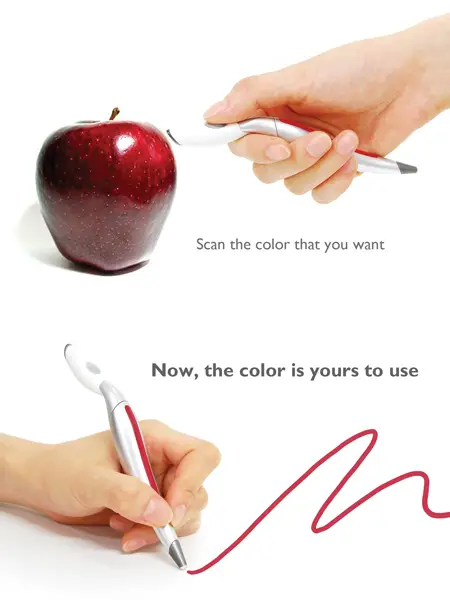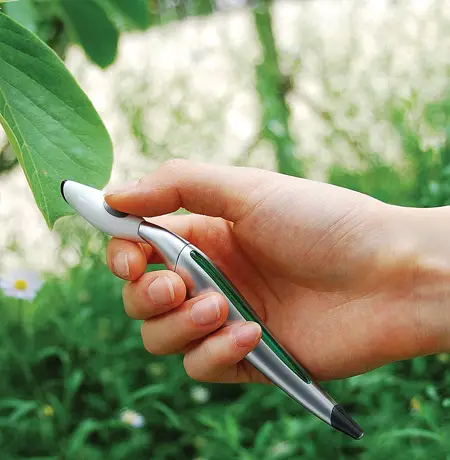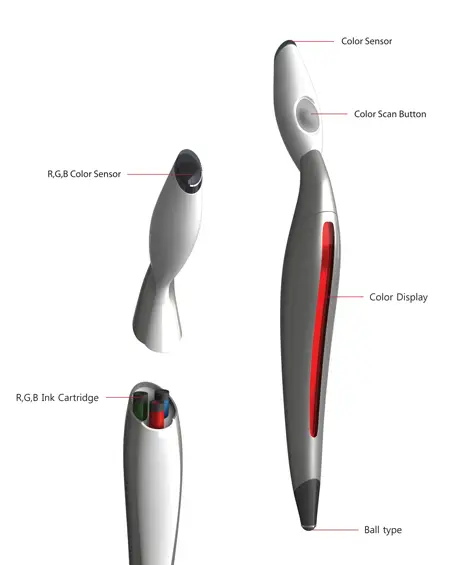Color Picker is an innovative design of a concept pen that can scan colors from anything around and instantly use the color for drawing. After placing the pen against an object, the user just presses the scan button. The color is being detected by the color sensor and the RGB cartridge of the pen mixes the required inks to create the target color. This superb device will help people to observe the changing colors of nature. With color picker, all range of artists will be able to cerate a more sensorial and visual insight of their surrounding nature’s colors.




Designer : Jinsun Park
*Some of our stories include affiliate links. If you buy something through one of these links, we may earn an affiliate commission.








we really impressed on this product. i want purchase this. where we can get it and how much it cost?
Where can I buy? How much does it cost?
Hell, I had an idea for this thing years ago, but it was for a thing that plugged into your computer and acted like an eyedropper tool for Photoshop or something. This is way cooler.
Nice concept, unfortunately impossible to create. I hate to break it to you, but RGB work with light but not with actual pigment.
You think this wont work because they wont be able to mix colors? really?! because no has ever been able to take red and blue and make purple right? that totally makes sense…
Yeah, the real insurmountable hurdle in this is that they used RGB instead CMYK… #no
Regarding the RGB/CMYK issue: Even if there was a color conversion and a CMYK ink mixing unit involved, CMYK doesn’t nearly have the same color space (gamut). Therefore, many natural colors with high saturation cannot be reproduced in CMYK.
Nonetheless, I think this idea could work as a portable real-world color picker with a small amount of memory for RGB codes. I’d buy that.
CMYK can’t work? Well then exactly how does a colour inkjet produce full colour photos?
The real thing is that no model (whether RGB or CMYK) can produce full range of colours visible to human eye. The L*A*B colour model can produce largest gamut of colours among all, but it is still unable to produce all colours visible to human eye. This is mentioned in Adobe Photoshop manual, where i read this recently. However, i think the device could work better with CMYK model because we are more used to that in print. However this device seems to be cool and a great fun tool to enjoy!
where can i buy it im in dubai
Well, it is true that RGB cartridges would not work at all (think for a moment, how do you mix for a colour like yellow?).
The CMYK cartridges make more sense but still have some problems. Imagine you want to create a pale magenta. Ok, you inject ink just from the magenta cartridge but how do you create a pale magenta and not a fully tinted magenta? The only way i think it could work is with a fifth cartridge with transparent ink so you can add a little drops of magenta to the transparent ink to create the pale magenta. I don't know if such a device can be created in the limited space of a stylus. It is not exactly like an inkjet printer head and cartridge. The printer drops tiny drops of ink on the paper that generate the visual effect of the desired colours but this device should continually generate an homogeneous mix of ink and it should be ready to generate a different mix as son as you scan a new colour, so what does it do with the previos ink still in the deposit? it should be a very tiny deposit and you probably had the draw a few lines in a paper until the new colour flows clean. But imagine a printer, take off all the moving parts that move the paper in and out and the print head left to right. Just keep the printer head, ink cartridges and circuitry. And you still have to fit all this stuff into a stylus, batteries included!
But a device that makes more sense, it is fairy simply to produce and still very useful for digital artists would be the colour picker with an USB interface to use with paint programs. Imagine you can point it to an object and use its colour in the program or ever better for illustrators: you can point the device to a pantone sample and use that exact colour in your design. Or point it to a previously designed object and determine what pantone colour is the closest for using it in their corporate imagery.
To Juan C Walls’ point about pale magenta, how about instead of black you used white ink? This would allow for proper lightening of inks in a continuous ink stream as seen in ball point pens with only modest degradation in darker colors(since mixing magenta, cyan and yellow rarely results in pure black). You would have to do this since printers achieve the same effect by producing fewer dots of ink in a given area and you just don’t have that luxury in a pen.
It's a cool idea! However, as others have pointed out — but as many others have utterly failed to understand — to mix Red/Green/Blue inks is doomed to failure. If I scan a lemon or a banana — how the hell would the necesary yellow color be mixed? It's mpossible do do from an RGB inkset. Ditto for many other colros. So only a Cyan/Maganta/Yellow inkset could make this "color-copier" work.
hi
please send me your phone namber and email adress .
i whant information abute scan colors from anything around and instantly use the color for paint on the metal .thank you
Where can I buy color cut? How much does it cost?
and i whant to use in paint of metal.
thank you to halpe me
i have a color piker, and it’s amazingly like a digital camera.
Que loucura, muito interessante!
how much cost this pen
Yes It very interesting that small thing.
Awesome idea but it's gonna be so expensive and ink will have to be replaced regularly making it cost more in the long run.
awesome
what happens is i scan a yellow based color?
As an artist's tool, they should have used a CMYK system. RGB is only good when creating color using light, not ink.
As an artist's tool, they should have used a CMYK system. RGB is only good when creating color using light, not ink.
Great idea, but there's a big difference between a product at its conceptual stage and a tangible product.
Great idea, but there's a big difference between a product at its conceptual stage and a tangible product.
Great idea, but there's a big difference between a product at its conceptual stage and a tangible product.
Great idea, but there's a big difference between a product at its conceptual stage and a tangible product.
Great idea, but there's a big difference between a product at its conceptual stage and a tangible product.
Great idea, but there's a big difference between a product at its conceptual stage and a tangible product.
It sounds a reall good innovative idea. I would love to get one of these. Please send me the detail on from where I can purchase it.
awwwwwwwwsome
With color picker, all range of artists will be able to cerate a more sensorial and visual insight of their surrounding nature’s colors.
With color picker, all range of artists will be able to cerate a more sensorial and visual insight of their surrounding nature’s colors.
how do you make such a cool pen? When does it come out? I would love to have one of those pens so I could draw with it. When will it come out!!!!!???? I really need it.
where can I get this?
It'd be a fantastic tool for artists who have color vision problems. There's actually a surprising number of us, and usually we use color theory rather than color perception to work, usually working in RGB instead of CMYK values because they're simpler.
I'd finally be able to work up an accurate color picture in traditional medium, rather than people complaining that I used gray instead of pink or red instead of green!
Sort of like a wheelchair for the colorblind. 😀
badly want to get one ~~~~~~~
I think it would be much better to have a catridge with red, blue and yellow instead of green, since red, blue and yellow are the basic colors…
This is fantastic! But the input should be RGB and the output ink CMYK. That'd add an extra cartridge.
It is only idea or realized product?
Awesome!!! When will it be put on the market??
soon
RGB pen? Really? Think again, please.
shut up and take my money!
Forr all the fellow designers around complaining about the RGB cartridge: At first i pointed out that issue, but it could actually make even more sense that using the regular CMYK system for this pen. Think about it; RGB is based on light addition to achieve any visible color. What if the pen works by writing using bits of RGB inks, not mixing it inside the pen body somehow but rather creating a matrix into the paper?
Step far enough and the good optics will do the rest of the job. I've seen it before, and it works.
Wanter to say this exact thing
What those of you who are critical about using the RGB color system do not realize is that the CMYK (red, yellow, blue) cannot be used when simply looking at light. Light mixes using the colors red, green, and blue. So, in order to do this without needing several extra computations, one would have to use the RGB. It might be conceivable to do things this way…
Inks are subtractive colour. So you simply must use CMYK. On your computer screen "White" is red, green, and blue added together. If you want a black on your computer screen it is no red, green, or blue. So RGB colour, as it is, cannot translate to paper. If you instruct the pen to print out full levels of RGB it would not be white, if you told it to print no RGB it would not be black. RGB is additive colour and it makes sense for LED pixels adding light together. Red light on a screen is just turning on (adding) red light.
Colour of materials, contrary to LEDs, is subtractive. A red you see in a material (i.e. paper, fabric) is an instance of cyan light being absorbed by the material. Red material subtracts cyan light from white light that hits it and reflects red light. A cyan pixel is additive, it is green light and blue light adding together emitting cyan.
A real life example is printers. No printer prints with red ink, blue ink, and cyan ink. Open your epson, brother, samsung, whatever you own. It has CMYK colours because that is how you colour a material to reflect the correct colour under ambient light.
Exactly. You can't use RGB for pigments. Thank you!
Finally, this concept explained in a way I could understand it! Thank you!
If this was feasible, you'd see printers doing it this way instead of using CMYK. See Yoseph's post.
You will always have a bleeding effect with ink, so a matrix is not a viable solution.
Common misconception. Cyan (blue-ish), Magenta (red-ish) and Yellow are the primary color for ink tones (black is used in printers as well). Red, Green and Blue are the primary colors for light. In elementary school they used Red, Blue and Yellow to keep the colors familiar for the younglings.
The difference is that light is additive, whereas ink is subtractive. This makes a difference when you're talking about something which emits light (such as your computer's monitor) versus something that is colored (like an apple, or painting).
This is case of the concept being incorrect. Jinsun is probably familiar with the primary light colors and used this in the concept design. If such a pen is ever really used, they will use CMYK for the ink colors.
thanks to u.. this ans of urs helped me with the confusion of why to consider green in primary colours instead of yellow…. thanks alot…
Wanted to buy … but no information about purchasing is this fake?
It's only concept, you can't buy it
How much? I hope it's not too expensive. How large is the area the "color picker" picks from? Is the size of the area adjustable? Does it interpolate adjacent "pixels" into one "perceived" color? ..and yes, why aren't the ink colors CMYK? What about the size of the pen tip? ~ alright, I've now wasted an hour horsing around with this post, and what did I get out of it? Was I able to order a pen? What did Tuvie get out of it? My email address? Congratulations. I'll unsubscribe right away. Thanks for nothing. Back to Photoshop.
I absolutely LOVE this idea and product! Where in the world can I find one?